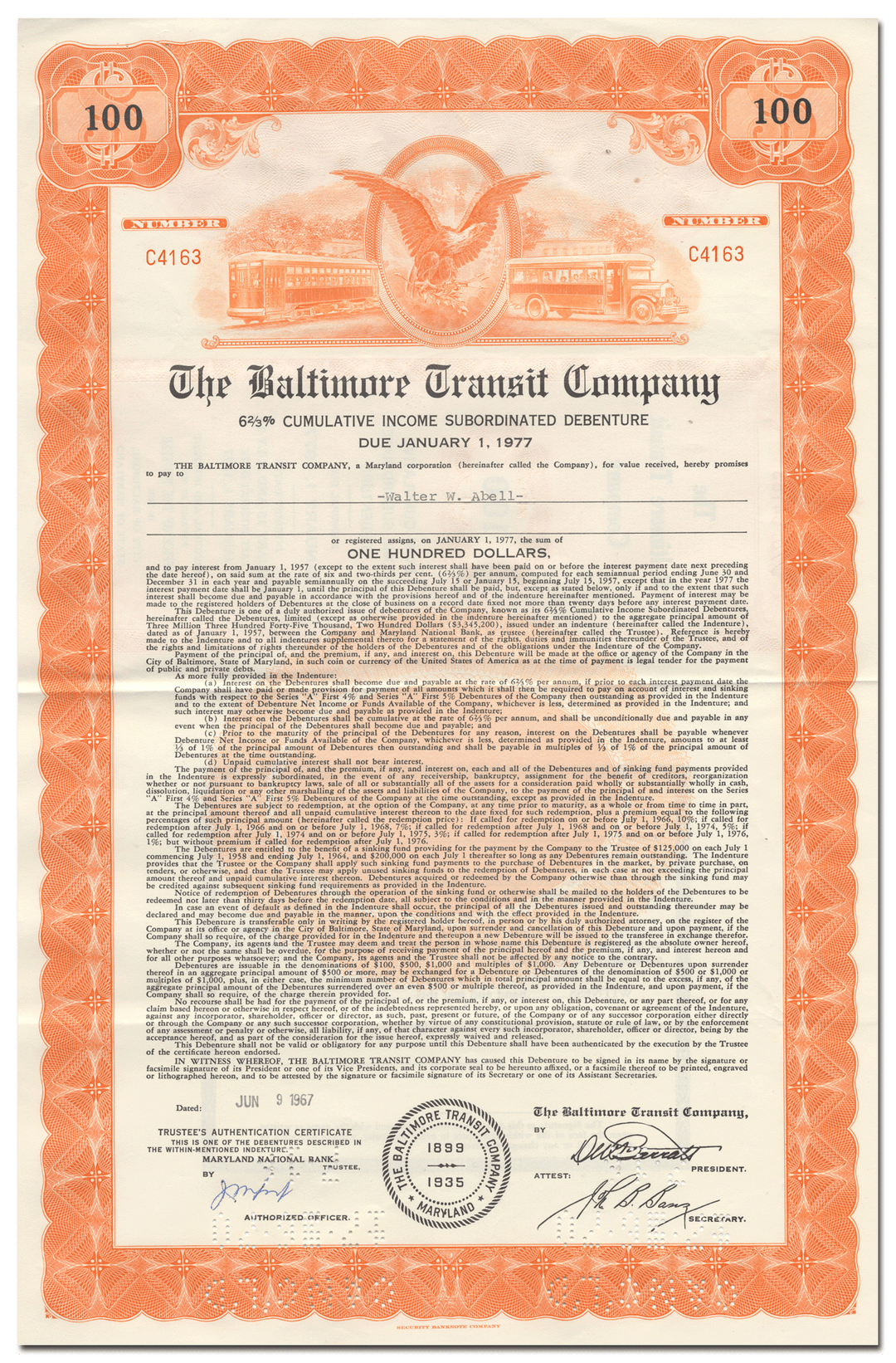Baltimore Transit Company
- Only 1 available!!
- Backordered, shipping soon
- Guaranteed authentic document
- Orders over $35 ship FREE to U. S. addresses
Product Details
CompanyBaltimore Transit Company
Certificate Type
Income Subordinated Debenture Bond
Date Issued
June 9, 1967
Canceled
Yes
Printer
Security Bank Note Company
Signatures
Machine printed
Approximate Size
10" (w) by 15 1/2" (h)
Images
Representative of the piece you will receive
Guaranteed Authentic
Yes
Additional Details
NA
Reference
Historical Context

In 1935 the Baltimore Transit Company (BTC) was formed to try to resurrect the ailing Baltimore transit system. At first, the system began a balanced approach to investing in the purchase of new buses and streetcars, as well as trackless trolley coaches, a hybrid of the two modes. Studies were conducted to try to evaluate the best modes for each individual line, and modernization and expansion were stressed to be able to remain competitive in the difficult environment.
BTC's biggest shot in the arm came in 1941, when the US entered World War II. Anticipating the call to arms, BTC had wisely stored its retired streetcars instead of scrapping them, so it was prepared for the eventual war effort. Rubber and gasoline were precious items to the war effort, so they were rationed, forcing a massive number of the public back to the rails for their commutes. No new buses were able to be ordered from 1942 until mid-1945, but the company was able to secure a number of modern streetcars during this time, as well as a handful of extra trackless trolleys. The profits realized by the wartime years were short lived however, and attitudes on public transit quickly changed in the years following the war. The control of the BTC by out of town interests concerned with the automotive, tire, and petroleum industries did not help matters at all either, as the comprehensive rail network was almost entirely dismantled in a mere ten years.
In the 1950's, the decentralization of the metropolitan area, caused to further bleed the heart of the transit system dry. While the BTC continued to convert rail lines to bus lines (with a few conversions to Trackless Trolley), with the support of Traffic Engineer Henry Barnes, in its efforts to save money by avoiding necessary infrastructure investments, the public continued to abandon the lines for the convenience of their automobiles. By 1955, only five lines remained to be operated by streetcars, along with a minor rail shuttle that was converted before year's end. By 1959, this number was down to only two, albeit among the heaviest routes in the system. Buses had replaced the rest of the routes, if in fact they weren't abandoned, as the system tried a desperate effort to reach out into the ever expanding suburbs in its attempts to regain lost business. Six trackless lines that had existed at the start of 1956 were all converted by mid-1959 as well.
As the 1960's dawned, the BTC was in the midst of its own downward spiral. They had desired to convert the remaining two rail lines to bus, but did not have enough capital to purchase replacement buses and repave the streets as well. Thus, the streetcars hung on until November 3, 1963, at which point the system became entirely operated by buses. However, the buses were no more successful (if not less so) at regaining ridership to the Baltimore system. BTC had grappled with labor strikes throughout this period, and each one only deterred the remaining ridership on the system. By the late 1960's, it had become obvious that transit was never going to be a lucrative, profitable venture, and State takeover became imminent. The Metropolitan Transit Authority (later renamed the Mass Transit Administration, always referred to as the "MTA") took over the operation of the BTC on April 30, 1970.
Related Collections
Additional Information
Certificates carry no value on any of today's financial indexes and no transfer of ownership is implied. All items offered are collectible in nature only. So, you can frame them, but you can't cash them in!
All of our pieces are original - we do not sell reproductions. If you ever find out that one of our pieces is not authentic, you may return it for a full refund of the purchase price and any associated shipping charges.







